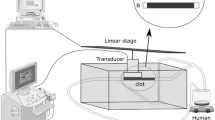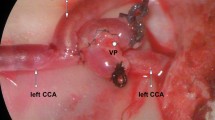Abstract
The goal of this study was to develop an in vivo sonothrombolysis model for stroke research. The rabbit carotid artery has average vessel diameters similar to human M1/M2 segments and allows generation of a thrombotic occlusion using various kinds of thrombus material as well as thrombus placement under visual control. It further allows real-time monitoring of flow and clot mechanics during the sonothrombolysis procedure using high-frequency diagnostic ultrasound. In the present study, the model will be introduced and first results to show feasibility using diagnostic as well as high-intensity focused ultrasound will be presented.






Similar content being viewed by others
References
Alexandrov AV, Mikulik R, Ribo M, et al. A pilot randomized clinical safety study of sonothrombolysis augmentation with ultrasound-activated perflutren-lipid microspheres for acute ischemic stroke. Stroke. 2008;39(5):1464–9.
Alexandrov AV, Molina CA, Grotta JC, et al. Ultrasound-enhanced systemic thrombolysis for acute ischemic stroke. N Engl J Med. 2004;351(21):2170–8.
Molina CA, Barreto AD, Tsivgoulis G, et al. Transcranial ultrasound in clinical sonothrombolysis (TUCSON) trial. Ann Neurol. 2009;66(1):28–38.
Eggers J, Konig IR, Koch B, Handler G, Seidel G. Sonothrombolysis with transcranial color-coded sonography and recombinant tissue-type plasminogen activator in acute middle cerebral artery main stem occlusion: results from a randomized study. Stroke. 2008;39(5):1470–5.
Eggers J, Seidel G, Koch B, Konig IR. Sonothrombolysis in acute ischemic stroke for patients ineligible for rt-PA. Neurol. 2005;64(6):1052–4.
Braaten JV, Goss RA, Francis CW. Ultrasound reversibly disaggregates fibrin fibers. Thromb Haemost. 1997;78(3):1063–8.
Devcic-Kuhar B, Pfaffenberger S, Gherardini L, et al. Ultrasound affects distribution of plasminogen and tissue-type plasminogen activator in whole blood clots in vitro. Thromb Haemost. 2004;92(5):980–5.
Pfaffenberger S, Devcic-Kuhar B, El-Rabadi K, et al. 2 MHz ultrasound enhances t-PA-mediated thrombolysis: comparison of continuous versus pulsed ultrasound and standing versus travelling acoustic waves. Thromb Haemost. 2003;89(3):583–9.
Datta S, Coussios CC, Ammi AY, Mast TD, de Courten-Myers GM, Holland CK. Ultrasound-enhanced thrombolysis using Definity((R)) as a cavitation nucleation agent. Ultrasound Med Biol. 2008;34(9):1421–33.
Schafer S, Kliner S, Klinghammer L, et al. Influence of ultrasound operating parameters on ultrasound-induced thrombolysis in vitro. Ultrasound Med Biol. 2005;31(6):841–7.
Datta S, Coussios CC, McAdory LE, et al. Correlation of cavitation with ultrasound enhancement of thrombolysis. Ultrasound Med Biol. 2006;32(8):1257–67.
Behrens S, Daffertshofer M, Spiegel D, Hennerici M. Low-frequency, low-intensity ultrasound accelerates thrombolysis through the skull. Ultrasound Med Biol. 1999;25(2):269–73.
Holscher T, Raman R, Ernstrom K, et al. In vitro sonothrombolysis with duplex ultrasound: first results using a simplified model. Cerebrovasc Dis. 2009;28(4):365–70.
Alonso A, Dempfle CE, Della Martina A, et al. In vivo clot lysis of human thrombus with intravenous abciximab immunobubbles and ultrasound. Thromb Res. 2009;124(1):70–4.
Dijkmans PA, Juffermans LJ, Musters RJ, et al. Microbubbles and ultrasound: from diagnosis to therapy. Eur J Echocardiogr. 2004;5(4):245–56.
Daffertshofer M, Gass A, Ringleb P, et al. Transcranial low-frequency ultrasound-mediated thrombolysis in brain ischemia: increased risk of hemorrhage with combined ultrasound and tissue plasminogen activator: results of a phase II clinical trial. Stroke. 2005;36(7):1441–6.
Siegel RJ, Atar S, Fishbein MC, et al. Noninvasive transcutaneous low frequency ultrasound enhances thrombolysis in peripheral and coronary arteries. Echocardiogr. 2001;18(3):247–57.
Frenkel V, Oberoi J, Stone MJ, et al. Pulsed high-intensity focused ultrasound enhances thrombolysis in an in vitro model. Radiol. 2006;239(1):86–93.
Rosenschein U, Furman V, Kerner E, Fabian I, Bernheim J, Eshel Y. Ultrasound imaging-guided noninvasive ultrasound thrombolysis: preclinical results. Circ. 2000;102(2):238–45.
Daffertshofer M, Huang Z, Fatar M, et al. Efficacy of sonothrombolysis in a rat model of embolic ischemic stroke. Neurosci Lett. 2004;361(1–3):115–9.
Saguchi T, Onoue H, Urashima M, Ishibashi T, Abe T, Furuhata H. Effective and safe conditions of low-frequency transcranial ultrasonic thrombolysis for acute ischemic stroke: neurologic and histologic evaluation in a rat middle cerebral artery stroke model. Stroke. 2008;39(3):1007–11.
Culp WC, Flores R, Brown AT, et al. Successful microbubble sonothrombolysis without tissue-type plasminogen activator in a rabbit model of acute ischemic stroke. Stroke. 2011;42(8):2280–5.
Flores R, Hennings LJ, Lowery JD, Brown AT, Culp WC. Microbubble-augmented ultrasound sonothrombolysis decreases intracranial hemorrhage in a rabbit model of acute ischemic stroke. Invest Radiol. 2011;46(7):419–24.
Culp WC, Erdem E, Roberson PK, Husain MM. Microbubble potentiated ultrasound as a method of stroke therapy in a pig model: preliminary findings. J Vasc Interv Radiol. 2003;14(11):1433–6.
Marder VJ, Chute DJ, Starkman S, et al. Analysis of thrombi retrieved from cerebral arteries of patients with acute ischemic stroke. Stroke. 2006;37(8):2086–93.
Rasmussen LE, Vanhoutte PM, Jensen BL, Skott O. Continuous flow augments reactivity of rabbit carotid artery by reducing bioavailability of NO despite an increase in release of EDHF. Am J Physiol Heart Circ Physiol. 2006;291(4):H1521–8.
Serrador JM, Picot PA, Rutt BK, Shoemaker JK, Bondar RL. MRI measures of middle cerebral artery diameter in conscious humans during simulated orthostasis. Stroke. 2000;31(7):1672–8.
Holscher T, Wilkening WG, Molkenstruck S, Voit H, Koch C. Transcranial sound field characterization. Ultrasound Med Biol. 2008;34(6):973–80.
Hoelscher T FD, Raman R, Ernstrom K, Zadicario E, Bradley WG, Voie A. Noninvasive transcranial clot lysis using high intensity focused ultrasound. Journal of Neurology and Neurophysiology 2011;S1-002.
Poliachik SL, Chandler WL, Mourad PD, et al. Effect of high-intensity focused ultrasound on whole blood with and without microbubble contrast agent. Ultrasound Med Biol. 1999;25(6):991–8.
Abramowicz JS, Miller MW, Battaglia LF, Mazza S. Comparative hemolytic effectiveness of 1 MHz ultrasound on human and rabbit blood in vitro. Ultrasound Med Biol. 2003;29(6):867–73.
Williams AR, Chater BV, Allen KA, Sherwood MR, Sanderson JH. Release of beta-thromboglobulin from human platelets by therapeutic intensities of ultrasound. Br J Haematol. 1978;40(1):133–42.
Kornowski R, Meltzer RS, Chernine A, Vered Z, Battler A. Does external ultrasound accelerate thrombolysis? Results from a rabbit model. Circ. 1994;89(1):339–44.
Acknowledgments
This work has been supported by the National Institute of Health (R01HL091043-01A2) and InSightec, Inc., Tirat Carmel, Israel. We would like to thank very much Cheryl Schendel and Daniel Lotz who contributed significantly to the development of the model.
Author information
Authors and Affiliations
Corresponding author
Rights and permissions
About this article
Cite this article
Hölscher, T., Fisher, D.J., Ahadi, G. et al. Introduction of a Rabbit Carotid Artery Model for Sonothrombolysis Research. Transl. Stroke Res. 3, 397–407 (2012). https://doi.org/10.1007/s12975-012-0194-5
Received:
Revised:
Accepted:
Published:
Issue Date:
DOI: https://doi.org/10.1007/s12975-012-0194-5




